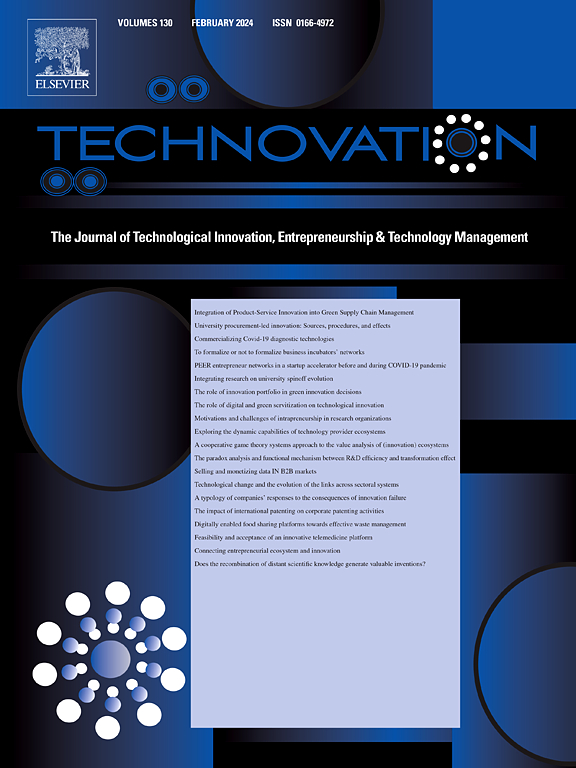从制度到实践:知识产权保护如何促进协同创新行为、数量和质量,由学术经验丰富的高管调节
IF 10.9
1区 管理学
Q1 ENGINEERING, INDUSTRIAL
引用次数: 0
摘要
知识产权保护与协同创新之间的矛盾关系需要深入研究。本研究采用“宏观政策到微观实施”的方法,从立法和执法两个维度对中国知识产权保护强度进行测度。本文利用2008 - 2018年各行业上市公司17376个样本数据集,构建了一个调节效应模型,考察了学术经验丰富的高管在知识产权保护与协同创新关系中的调节作用。具体而言,我们从行为、数量和质量三个维度分析协同创新绩效。研究发现:(1)知识产权保护显著提高了企业协同创新行为、数量和质量。知识产权保护力度越强,对协同创新数量和质量的正向影响越大;(2)有学术经历的高管强化了正相关关系,呈现出正向调节效应。这一结果适用于协作创新的所有三个维度:行为、数量和质量。在同等知识产权保护下,高管学术经验越丰富的企业协同创新绩效越好,特别是在高质量协同创新数量方面。在此基础上,建议中国加强知识产权保护,提高执法效率。优化专门针对协同创新的知识产权保护条款,合理分配协同创新收益,优化企业创新管理策略。同时,鼓励学术经验丰富的高管参与企业决策,可以进一步提高协同创新的行为、数量和质量,即使在相同的知识产权保护环境下。本文章由计算机程序翻译,如有差异,请以英文原文为准。
From institution to practice: How intellectual property protection promotes collaborative innovation behavior, quantity, and quality, moderated by academically experienced executives
The paradoxical relationship between intellectual property protection and collaborative innovation requires in-depth investigation. This study adopts a “macro policy to micro implementation” approach, integrating both legislative and enforcement dimensions to measure the intellectual property protection intensity in China. Using a dataset of 17,376 samples from listed companies across all industries from 2008 to 2018, we develop a moderation effect model to examine the role of academically experienced executives in moderating the relationship between intellectual property protection and collaborative innovation. Specifically, we analyze collaborative innovation performance from three dimensions: behavior, quantity, and quality. The findings reveal that: (1) Intellectual property protection significantly enhances firms' collaborative innovation behavior, quantity, and quality. Moreover, stronger intellectual property protection has a greater positive impact on the quantity and quality of collaborative innovation; (2) Academically experienced executives strengthen the positive relationship, demonstrating a positive moderating effect. This result applies to all three dimensions of collaborative innovation: behavior, quantity, and quality. Under the same intellectual property protection, firms with more academically experienced executives exhibit better collaborative innovation performance, particularly in terms of high-quality collaborative innovation quantity. Based on these findings, it is recommended that China strengthen intellectual property protection and improve enforcement efficiency. Additionally, optimize intellectual property protection clauses specifically targeting collaborative innovations, reasonably distribute the benefits of collaborative innovations, and optimize corporate innovation management strategies. Meanwhile, encouraging academically experienced executives to participate in corporate decision-making can further increase the behavior, quantity, and quality of collaborative innovations even under the same intellectual property protection environment.
求助全文
通过发布文献求助,成功后即可免费获取论文全文。
去求助
来源期刊

Technovation
管理科学-工程:工业
CiteScore
15.10
自引率
11.20%
发文量
208
审稿时长
91 days
期刊介绍:
The interdisciplinary journal Technovation covers various aspects of technological innovation, exploring processes, products, and social impacts. It examines innovation in both process and product realms, including social innovations like regulatory frameworks and non-economic benefits. Topics range from emerging trends and capital for development to managing technology-intensive ventures and innovation in organizations of different sizes. It also discusses organizational structures, investment strategies for science and technology enterprises, and the roles of technological innovators. Additionally, it addresses technology transfer between developing countries and innovation across enterprise, political, and economic systems.
 求助内容:
求助内容: 应助结果提醒方式:
应助结果提醒方式:


